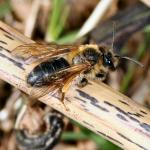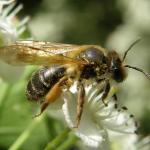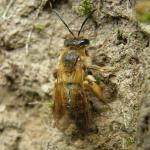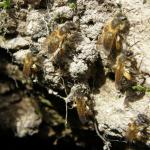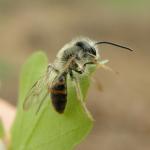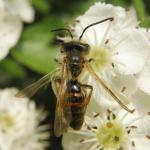Andrena distincta Smith, 1847 (nec. Lucas, 1849, nec Schenck, 1861); Andrena obscurata Smith, 1853.
Very rarely encountered and confined to scattered sites in southern England. Females are often locally abundant if a nest has been located. The apparent rarity of this species may be partly explained by the habits of both sexes. Females have very localised nest sites and, on leaving, they seem to fly high up to forage in the canopy of oaks (the flowering period of this tree is also very short). Males too visit the flowers of trees and shrubs for nectar. The species is similarly rare on the continent (e.g. Westrich, 1989), with records from The Netherlands, Belgium, France, Spain, Germany, Switzerland, northern Italy, the Czech Republic, Bosnia, Crimea and the Carpathian Basin (see Leys, 1978).
Classified as Endangered (RDB1) in the Red Data Book (Shirt, 1987) and by Falk (1991).
Mainly known from open, deciduous woodland. In eastern Europe, males have been reported as flying around oaks and copulating with females on the leaves, often at a height of 4-5 metres (Kocourek, 1966). With a sudden change of weather both sexes shelter under the flowers of shrubs, mainly hawthorn (Crataegus monogyna), where they may also spend the night (Kocourek, 1966).
Univoltine; late April to early June.
This species nests communally in burrows excavated in the soil, many females sharing a common nest entrance. In The Netherlands, each communal nest may be inhabited by up to 80 females. Investigations in a meadow in the same country revealed an aggregation of about 200 such nests. It was estimated that the total female population in this site was about 15,000 (Leys, 1978).
Hawthorn, oak and sycamore. Also a white-flowered crucifer, possibly a species of mustard (G W Allen, pers. comm.).
In Britain, the cleptoparasitic bees Nomada flava Panzer and N. marshamella (Kirby) have been seen flying around the nest burrows of this Andrena (G R Else and S P M Roberts, pers. obs.; Yarrow & Guichard, 1941, respectively), the former species entering a nest burrow.
Proofed: February 2012


